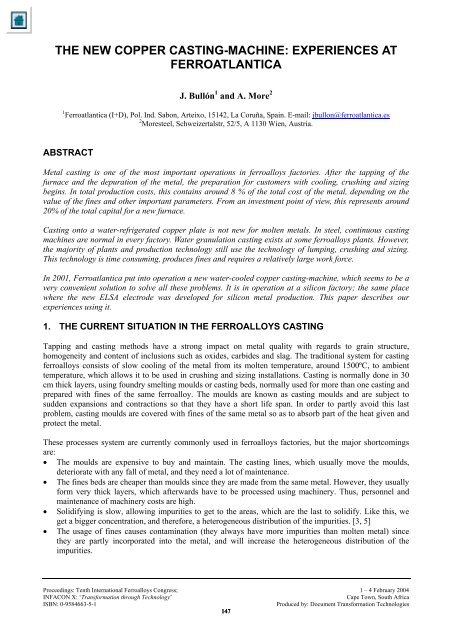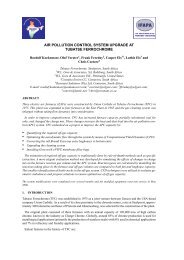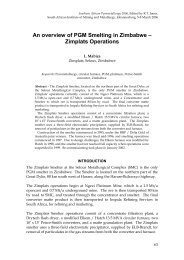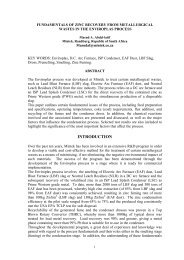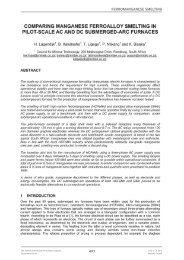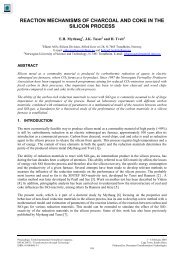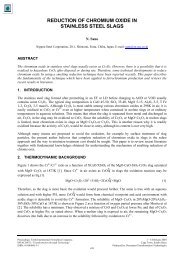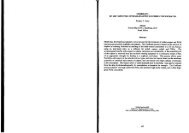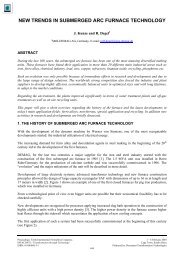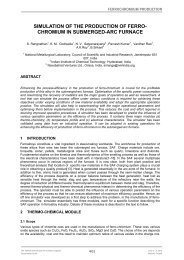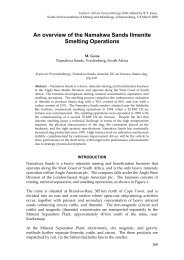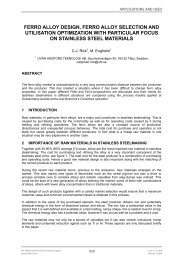The New Copper Casting-Machine: Experiences at ... - Pyro.co.za
The New Copper Casting-Machine: Experiences at ... - Pyro.co.za
The New Copper Casting-Machine: Experiences at ... - Pyro.co.za
You also want an ePaper? Increase the reach of your titles
YUMPU automatically turns print PDFs into web optimized ePapers that Google loves.
THE NEW COPPER CASTING-MACHINE: EXPERIENCES ATFERROATLANTICAJ. Bullón 1 and A. More 21 Ferro<strong>at</strong>lantica (I+D), Pol. Ind. Sabon, Arteixo, 15142, La Coruña, Spain. E-mail: jbullon@ferro<strong>at</strong>lantica.es2 Moresteel, Schweizertalstr, 52/5, A 1130 Wien, Austria.ABSTRACTMetal casting is one of the most important oper<strong>at</strong>ions in ferroalloys factories. After the tapping of thefurnace and the depur<strong>at</strong>ion of the metal, the prepar<strong>at</strong>ion for customers with <strong>co</strong>oling, crushing and sizingbegins. In total production <strong>co</strong>sts, this <strong>co</strong>ntains around 8 % of the total <strong>co</strong>st of the metal, depending on thevalue of the fines and other important parameters. From an investment point of view, this represents around20% of the total capital for a new furnace.<strong>Casting</strong> onto a w<strong>at</strong>er-refriger<strong>at</strong>ed <strong>co</strong>pper pl<strong>at</strong>e is not new for molten metals. In steel, <strong>co</strong>ntinuous castingmachines are normal in every factory. W<strong>at</strong>er granul<strong>at</strong>ion casting exists <strong>at</strong> some ferroalloys plants. However,the majority of plants and production technology still use the technology of lumping, crushing and sizing.This technology is time <strong>co</strong>nsuming, produces fines and requires a rel<strong>at</strong>ively large work force.In 2001, Ferro<strong>at</strong>lantica put into oper<strong>at</strong>ion a new w<strong>at</strong>er-<strong>co</strong>oled <strong>co</strong>pper casting-machine, which seems to be avery <strong>co</strong>nvenient solution to solve all these problems. It is in oper<strong>at</strong>ion <strong>at</strong> a sili<strong>co</strong>n factory; the same placewhere the new ELSA electrode was developed for sili<strong>co</strong>n metal production. This paper describes ourexperiences using it.1. THE CURRENT SITUATION IN THE FERROALLOYS CASTINGTapping and casting methods have a strong impact on metal quality with regards to grain structure,homogeneity and <strong>co</strong>ntent of inclusions such as oxides, carbides and slag. <strong>The</strong> traditional system for castingferroalloys <strong>co</strong>nsists of slow <strong>co</strong>oling of the metal from its molten temper<strong>at</strong>ure, around 1500ºC, to ambienttemper<strong>at</strong>ure, which allows it to be used in crushing and sizing install<strong>at</strong>ions. <strong>Casting</strong> is normally done in 30cm thick layers, using foundry smelting moulds or casting beds, normally used for more than one casting andprepared with fines of the same ferroalloy. <strong>The</strong> moulds are known as casting moulds and are subject tosudden expansions and <strong>co</strong>ntractions so th<strong>at</strong> they have a short life span. In order to partly avoid this lastproblem, casting moulds are <strong>co</strong>vered with fines of the same metal so as to absorb part of the he<strong>at</strong> given andprotect the metal.<strong>The</strong>se processes system are currently <strong>co</strong>mmonly used in ferroalloys factories, but the major short<strong>co</strong>mingsare:• <strong>The</strong> moulds are expensive to buy and maintain. <strong>The</strong> casting lines, which usually move the moulds,deterior<strong>at</strong>e with any fall of metal, and they need a lot of maintenance.• <strong>The</strong> fines beds are cheaper than moulds since they are made from the same metal. However, they usuallyform very thick layers, which afterwards have to be processed using machinery. Thus, personnel andmaintenance of machinery <strong>co</strong>sts are high.• Solidifying is slow, allowing impurities to get to the areas, which are the last to solidify. Like this, weget a bigger <strong>co</strong>ncentr<strong>at</strong>ion, and therefore, a heterogeneous distribution of the impurities. [3, 5]• <strong>The</strong> usage of fines causes <strong>co</strong>ntamin<strong>at</strong>ion (they always have more impurities than molten metal) sincethey are partly in<strong>co</strong>rpor<strong>at</strong>ed into the metal, and will increase the heterogeneous distribution of theimpurities.Proceedings: Tenth Intern<strong>at</strong>ional Ferroalloys Congress; 1 – 4 February 2004INFACON X: ‘Transform<strong>at</strong>ion through Technology’Cape Town, South AfricaISBN: 0-9584663-5-1Produced by: Document Transform<strong>at</strong>ion Technologies
<strong>The</strong> importance of points c) and d) depends on the customer who receives the product. For example, insili<strong>co</strong>n metal these points are of gre<strong>at</strong> importance for a chemical-grade customer, who wants a veryhomogeneous m<strong>at</strong>erial, and of less importance for an aluminium customer. <strong>The</strong> reason is th<strong>at</strong> tramp elementsin sili<strong>co</strong>n affect the reaction with CH 3 Cl in sili<strong>co</strong>nes production, and should be evenly distributed in thereactor. <strong>The</strong> tramp elements tend to solidify on the boundaries between the grains. With slow <strong>co</strong>oling, thesili<strong>co</strong>n crystals will be larger than the grains in the powder, and many grains will be essentially singlecrystals without grain boundaries. With smaller crystals the grain boundaries will be more evenly distributed,and most grains will <strong>co</strong>ntain some phases with tramp elements [3].In short, the standard system of casting needs the following oper<strong>at</strong>ions:• <strong>Casting</strong> from the ladle to the casting mould or to the fines beds.• Waiting until the m<strong>at</strong>erial is <strong>co</strong>ld and solidified sufficiently.• Moving the m<strong>at</strong>erial from the <strong>co</strong>oling area to the breaking up area.• Breaking up the m<strong>at</strong>erial into the first sizes.• Breaking the m<strong>at</strong>erial down to the customer’s requirements.• Picking up the fines and storing them in their own stock area.• Transporting the fines to the casting area and placing them into moulds.Figure 1. Conventional processing technology in a ferroalloys factory after metal tapping.Solidified ferroalloys need to be further crushed down to small lumps of up to 100 mm for use in customers’processes. This means it should go through two crushing processes and <strong>at</strong> least another two for sizing. <strong>The</strong>first is normally done in jaw crushers and the se<strong>co</strong>nd in roll crushers. <strong>The</strong>se oper<strong>at</strong>ions normally gener<strong>at</strong>esignificant amounts of fines, which are undesirable for their bigger impurities <strong>co</strong>ntent because the dominantfractures are transgranular. <strong>The</strong> production of fines is usually about 10%, taking into ac<strong>co</strong>unt th<strong>at</strong> them<strong>at</strong>erial is under 5 mm.
<strong>The</strong>se fines are either sold <strong>at</strong> a dis<strong>co</strong>unt of about 20% to lumpy product, or are resmelted in the same factoryin the furnace, in the bed, or in the casting mould. Fines <strong>co</strong>nstitute the main part of the impurities andfrequently the customer, who is <strong>co</strong>ncerned about chemical purity, asks for the percentage of fines to beresmelted in the casting moulds to be minimal.From the point of view of capital investment, space is needed for all these intermedi<strong>at</strong>e stocks, <strong>co</strong>olingplaces, etc., also for transporting machinery, such as bulldozers, travelling cranes and the breaking upinstall<strong>at</strong>ions in its two stages. In general all this takes up 25% of the area of a factory, and in a new factorymeans 20% of the investment.Staff and maintenance <strong>co</strong>sts for all these oper<strong>at</strong>ions obviously depend on each factory. In sili<strong>co</strong>n factories, anaverage figure of about 8% would be reasonable for the total <strong>co</strong>st for auxiliary works in the making of theproduct.Within this percentage there are two very important <strong>co</strong>ncepts, which are not included:• Losses of fines as a <strong>co</strong>nsequence of movements of stocks.• <strong>The</strong> loss of profits when the fines are sold <strong>at</strong> market prices, which are usually 20% below the <strong>co</strong>mmercialprices.In brief, all the tre<strong>at</strong>ments of the metal (from its molten st<strong>at</strong>e to its delivery to the customer) make up one ofthe most important <strong>co</strong>sts for a ferroalloy factory. Many efforts have been made to reduce such <strong>co</strong>sts and toimprove the quality and homogeneity of the product, for example w<strong>at</strong>er granul<strong>at</strong>ion. <strong>Casting</strong> onto <strong>co</strong>pperpl<strong>at</strong>es is an existing solution, the same as <strong>co</strong>ntinuous casting was for steel.2. REASONS FOR THE COPPER CASTING-MACHINE<strong>The</strong> decision to set up a <strong>co</strong>pper casting machine was taken when Ferro<strong>at</strong>lantica went into the chemical-gradesili<strong>co</strong>n market. <strong>The</strong> objective was to cast a thin layer (about 10/15 mm thick), to solidify this quickly, and notto use fines since they pollute part of the metal. Thus, a very pure and homogeneous metal would be obtainedboth in its liquid and solid st<strong>at</strong>es. <strong>The</strong>refore, we got in touch with Dr. Anton More, who has a p<strong>at</strong>ent on thissystem and who had had previous experience with it when he worked for the Wacker-Chemie <strong>co</strong>mpany inGermany before his retirement. Ferro<strong>at</strong>lantica I+D, the R&D <strong>co</strong>mpany of the Ferro<strong>at</strong>lantica Group, reachedan agreement with him, and the design for a machine which would allow for the casting of all of the factoryproduction was begun. This machine would also cast <strong>at</strong> different layer thicknesses and so c<strong>at</strong>er not only forthe chemical market, which requires thin layers, but also the aluminium one with thicker layers.<strong>The</strong> casting machine has been designed with enough capacity to cast all the production of the plant <strong>at</strong> acasting speed of around 150 kg/min. At Ferro<strong>at</strong>lantica (I+D), we have carried out, and are <strong>co</strong>ntinuing to doso, many studies and improvements with the object of achieving the most autom<strong>at</strong>ic and safest install<strong>at</strong>ionpossible. <strong>The</strong> machine has been running <strong>at</strong> normal production level since some months ago, and although wehave still not reached the full level of casting from the three furnaces, our customers are being supplied withproducts cast using it.3. MAIN FEATURES OF THE FERROATLANTICA COPPER CASTING-MACHINE<strong>The</strong> basic machine <strong>co</strong>nsists of one <strong>co</strong>pper table and two iron tables. <strong>The</strong> width and length of these tableshave been calcul<strong>at</strong>ed so th<strong>at</strong> the <strong>co</strong>oling of the elements is very efficient and the <strong>co</strong>pper, whose melting pointis somewh<strong>at</strong> more than 1000ºC can receive the molten metal which arrives <strong>at</strong> 1500 º C. <strong>The</strong> flow and speedof the w<strong>at</strong>er are very important parameters for the life span of the <strong>co</strong>oper pl<strong>at</strong>e and these were achievedthanks to a very adequ<strong>at</strong>e design of the refriger<strong>at</strong>ion circuit. <strong>The</strong>rmo<strong>co</strong>uples have been installed to measureboth the temper<strong>at</strong>ure of all the w<strong>at</strong>er circuits as well as of the <strong>co</strong>pper pl<strong>at</strong>e where the metal falls onto it. Allthis d<strong>at</strong>a is <strong>co</strong>ntrolled by a PLC, and one by one all the different oper<strong>at</strong>ions have been changed over toautom<strong>at</strong>ic.
Figure 2. Scheme of the casting machine <strong>at</strong> Ferro<strong>at</strong>lantica’s Sabon plant.<strong>The</strong> <strong>co</strong>pper and iron pl<strong>at</strong>es are placed on strong vibr<strong>at</strong>ing tables which have variable frequencies ac<strong>co</strong>rdingto the needs of the oper<strong>at</strong>ion. Since Ferro<strong>at</strong>lantica markets to both aluminum and sili<strong>co</strong>nes producers, arequirement was the ability to cast to different thicknesses of sili<strong>co</strong>n in order to s<strong>at</strong>isfy the requirements ofeach customer.<strong>The</strong> first piece of equipment of the machine is a tilting device. <strong>The</strong> ladle <strong>co</strong>ming from the furnace is <strong>at</strong>tachedto this. Using an autom<strong>at</strong>ic program the ladle is tilted so th<strong>at</strong> the quantity of metal th<strong>at</strong> falls onto the pl<strong>at</strong>e is<strong>co</strong>nstant. Before reaching the pl<strong>at</strong>e the metal passes through a runner which distributes it over the width ofthe pl<strong>at</strong>e. <strong>The</strong> molten metal <strong>co</strong>mes into <strong>co</strong>ntact with the w<strong>at</strong>er-<strong>co</strong>oled <strong>co</strong>pper and begins to solidify <strong>at</strong> thispoint as can be seen in Figure 3. When a certain thickness of solid metal is reached, the vibr<strong>at</strong>ions of thetable cause the metal, which is still molten on top, to begin to move along the <strong>co</strong>pper table. As can be seen inFigure 3, the solidific<strong>at</strong>ion <strong>co</strong>ntinuous from the bottom of the layer until it reaches a point where it meetswith the solidific<strong>at</strong>ion done by the radi<strong>at</strong>ion losses <strong>at</strong> the top of the sili<strong>co</strong>n. Before reaching the end of thetable, the metal is solidified but still red-hot on top (about 1100º C). When falling from the <strong>co</strong>pper pl<strong>at</strong>e ontothe first iron pl<strong>at</strong>e, the metal begins to break up which is favored by the vibr<strong>at</strong>ions of said table which, onone hand, transports the metal along it and <strong>at</strong> the same time breaks it up into pieces.Figure 3. Schem<strong>at</strong>ic of sili<strong>co</strong>n solidific<strong>at</strong>ion on the w<strong>at</strong>er-<strong>co</strong>oled <strong>co</strong>pper pl<strong>at</strong>e.<strong>The</strong> same thing happens when the metal passes on to the se<strong>co</strong>nd iron table, such th<strong>at</strong> on reaching the end ofthis table the metal is almost <strong>co</strong>mpletely broken up and is down to a temper<strong>at</strong>ure of 500ºC. Finally the metalfalls into a metal bin where all the m<strong>at</strong>erial from the ladle is stored and then taken to the stock area ac<strong>co</strong>rdingto its quality.<strong>The</strong> <strong>co</strong>pper and iron pl<strong>at</strong>es remain perfectly clean and without any remains of the casting. Since no type offines were in<strong>co</strong>rpor<strong>at</strong>ed, there is only and exclusively the m<strong>at</strong>erial from the ladle in the bin.Using this new casting machine, the metal stays on the <strong>co</strong>pper pl<strong>at</strong>e about 80 se<strong>co</strong>nds and the solidifying iscarried out in the first 30 se<strong>co</strong>nds. <strong>The</strong> metal which first fell out onto the <strong>co</strong>pper pl<strong>at</strong>e reaches the metal binin around 4 minutes and is now solid and broken up.
3.1 Safety and Video-Control System.It is a well-known fact th<strong>at</strong> the reaction of molten metal on w<strong>at</strong>er can cause explosions. Using the system ofdirect casting into w<strong>at</strong>er there have been neg<strong>at</strong>ive experiences of this type. However, these have been solvedusing various improvements and new technologies. <strong>The</strong>se are now running in many factories. In fact, all thesystems of <strong>co</strong>ntinuous casting in the steel industry have been able to over<strong>co</strong>me this potential problem.At Ferro<strong>at</strong>lantica, we have placed gre<strong>at</strong> importance on this risk, and, in the little more than a year th<strong>at</strong> wehave had this machine running, we have had no neg<strong>at</strong>ive experience in this sense. From the beginning of thetrials, we have autom<strong>at</strong>ed all the install<strong>at</strong>ions to a maximum in order to eradic<strong>at</strong>e the human error factor. <strong>The</strong>improvements have been in<strong>co</strong>rpor<strong>at</strong>ed step by step following the strictest principles for the safety of peopleand install<strong>at</strong>ions.In this regard, in the last few months we have in<strong>co</strong>rpor<strong>at</strong>ed a video-<strong>co</strong>ntrol system, which has autom<strong>at</strong>ed allpossible oper<strong>at</strong>ions in the casting system. <strong>The</strong> system analyses all the images received from the video andgives the appropri<strong>at</strong>e orders so as to increase or reduce the speed of the tilt of the ladle thus affecting theamount of metal, which falls onto the table. When the required amount of metal is on the table, the vibr<strong>at</strong>ionsystem is started up, thus taking away this metal and leaving space for liquid metal. <strong>The</strong> technicalpossibilities of this type of video <strong>co</strong>ntrol are very important and, in the future, it seems logical to also carryout vigilance <strong>co</strong>ntrol using this type of fe<strong>at</strong>ure.4. METAL QUALITY ADVANTAGES WITH THE COPPER CASTING-MACHINE<strong>The</strong> first advantage to be <strong>co</strong>nsidered is the purity of the product obtained. This is due to the following points:• Neither resmelted fines nor any other mould protection product are used.• <strong>The</strong> pouring or tilting process time is very long, 15 minutes, <strong>co</strong>mpared to the standard process, 5minutes, this allows for a better segreg<strong>at</strong>ion of slag.• Slag in sili<strong>co</strong>n is of a gre<strong>at</strong>er density and more vis<strong>co</strong>us than the metal. Because of this, it remains in therunner and does not fall onto the <strong>co</strong>pper pl<strong>at</strong>e.<strong>The</strong> se<strong>co</strong>nd advantage is the <strong>co</strong>oling speed. <strong>The</strong> product, as mentioned before, solidifies in a few se<strong>co</strong>nds. Itis not as fast as w<strong>at</strong>er granul<strong>at</strong>ion but is much quicker than solidifying in casting mould. This has animmedi<strong>at</strong>e influence on the size of the crystal in the pieces of sili<strong>co</strong>n. <strong>The</strong> grain size in the sili<strong>co</strong>n <strong>co</strong>mingfrom the casting mould is about 300 microns, whereas the one from the <strong>co</strong>pper pl<strong>at</strong>e is only 100 microns.Apart from this, in the former the grains closely follow the direction of the <strong>co</strong>oling. However, in the castingmould the crystals are totally disorganized, and their size, presence and orient<strong>at</strong>ion are different when<strong>co</strong>mparing a piece from the center of the mould, from a side-piece with fines or from the surface, which is in<strong>co</strong>ntact with the air.<strong>The</strong> metal cast onto this machine is called “grain orient<strong>at</strong>ed” and the uniformity in each of the final pieces ismuch gre<strong>at</strong>er than in sili<strong>co</strong>n casting in moulds. <strong>The</strong> high solidific<strong>at</strong>ion r<strong>at</strong>e modifies the intermetallic phasesdistribution which be<strong>co</strong>mes more uniform. This is associ<strong>at</strong>ed with a smaller grain size. In the photo(Figure 4), you can see the normal thickness of a thin layer, typical in the chemical market. In the photo(Figure 5) is a thicker layer, typical in the aluminium market. <strong>The</strong> crystals are really perpendicular to the<strong>co</strong>pper until they reach the m<strong>at</strong>erial solidified by radi<strong>at</strong>ion losses. At this area it is possible to see the end ofthe crystal with some small holes where the <strong>co</strong>ncentr<strong>at</strong>ion of impurities is higher. All the pieces are ofsimilar physical and chemical characteristics.Figure 4. Thin layer sili<strong>co</strong>n cast onto the machine.
Figure 5. Thicker layer sili<strong>co</strong>n cast onto the machine.<strong>The</strong> third big advantage is the reduction of fines. Using this system, you can get a layer, which is <strong>co</strong>nstantfrom a thickness point of view due to manipul<strong>at</strong>ing the <strong>co</strong>oling speed and the vibr<strong>at</strong>ion on the table. Thus, forfurther processing you must only address the other two dimensions. This can be done by a mechanicalhammer, turning it round, <strong>at</strong> the end of the machine and when the majority of the pieces have been broken upautom<strong>at</strong>ically by themselves.As the m<strong>at</strong>erial is broken up, some fines are to be found in sizes of less than 5 mm. However, on producingthe breaking up of the pieces, instead of mechanical crushing them, their percentage is much lower than th<strong>at</strong>when using <strong>co</strong>nventional sili<strong>co</strong>n casting mould. Our experience is reflected in table 1. Taking into ac<strong>co</strong>untth<strong>at</strong> the fines <strong>co</strong>me from the same ladle and its percentage is low (as is also the percentage of the very smallfines), we aim to sell the <strong>co</strong>pper pl<strong>at</strong>e cast m<strong>at</strong>erial as a sized by down product, i.e. X – 0mm, where X is thetop size requirement of the customer. We are also <strong>co</strong>mmitting our customers to accept this sizing for them<strong>at</strong>erial cast using <strong>co</strong>pper pl<strong>at</strong>e technology.Table 1. Sieve analysis after crushing to product size 0-120 mm, depending on the casting method.<strong>Casting</strong> method Conventional <strong>Casting</strong> machineResidue on sieve 5 mm 90% 97%Residue on sieve 1 mm 96% 99%5. IMPROVEMENTS IN THE FACTORY PROCESS<strong>The</strong> introduction of this casting machine <strong>co</strong>mpletely changes the organiz<strong>at</strong>ion of the department, which is incharge of the outlet of the finished product; th<strong>at</strong> is to say, they receive the m<strong>at</strong>erial from the productiondepartment and do the processing tre<strong>at</strong>ment until it is disp<strong>at</strong>ched from the factory by lorry. Both the crushingof big pieces and then the se<strong>co</strong>nd crushing are elimin<strong>at</strong>ed. By reaching an agreement on equal sizing fordifferent customers, you can even elimin<strong>at</strong>e screening and classific<strong>at</strong>ion. At factories already in oper<strong>at</strong>ion,the introduction of this technology requires a <strong>co</strong>ordin<strong>at</strong>ed effort of the organiz<strong>at</strong>ion of the processes, of the<strong>co</strong>mmercial division and of the customers. This is not always easy to achieve. In green fields projects, thefactory itself must be built taking into ac<strong>co</strong>unt the existence of this type of machine opposed to thetraditional ones in our sector. <strong>The</strong> ideal would be to have only one department where casting and storage arecarried out instead of the two departments, which exist <strong>at</strong> the present: one for casting and the other for theclassific<strong>at</strong>ion silos.We have already st<strong>at</strong>ed th<strong>at</strong> the casting process can be done autom<strong>at</strong>ically. <strong>The</strong> oper<strong>at</strong>ive only carries outvigilance work of the process and it is foreseeable in the near future th<strong>at</strong> said oper<strong>at</strong>ive will carry out otherstasks in the area during the casting time leaving the vigilance work to the video machines.On leaving the table, the m<strong>at</strong>erial is stored in metal bins. Following the same principle of autom<strong>at</strong>ion, in thiscase using a traveling crane, said bins can be emptied into the silo which <strong>co</strong>rresponds to the quality whichhas been cast <strong>at</strong> th<strong>at</strong> moment. It is even possible to directly fill the <strong>co</strong>ntainers, which will leave the factory,thus avoiding any human intervention wh<strong>at</strong>soever. Since no traces of m<strong>at</strong>erial are left on the table, there is no<strong>co</strong>ntamin<strong>at</strong>ion between different product qualities and you can cast two different products altern<strong>at</strong>ely, takingthe same either to different silos or to different <strong>co</strong>ntainers.
All this allows for an important reduction of personnel in the finished products department and a<strong>co</strong>nsiderable saving in <strong>co</strong>sts of the final product, besides improving product quality. To do this, it isnecessary to have <strong>at</strong> least two machines in the factory so as to avoid reverting back to the traditional methodif there is a stoppage on one machine. This traditional method requires a large work force and the factorymight still not be ready for this.6. OTHERS SAVINGSAnother big advantage is the savings <strong>co</strong>mpared to present day situ<strong>at</strong>ions. In the new casting machine, themost <strong>co</strong>st effective part of the whole casting machine is the life span of the <strong>co</strong>pper pl<strong>at</strong>e, and in this, the mostcritical area is where the liquid sili<strong>co</strong>n, <strong>at</strong> about 1500ºC, meets the surface of the <strong>co</strong>pper. We have made avery special design of the w<strong>at</strong>er-<strong>co</strong>oling of the <strong>co</strong>pper following the re<strong>co</strong>mmend<strong>at</strong>ions of Dr. Anton Moreand, <strong>at</strong> the moment, with more than 3.000 he<strong>at</strong>ing we have not experienced any problems, due to the qualityof the <strong>co</strong>pper and the very good <strong>co</strong>oling capacity, and only very little mechanical erosion. Last year weexpected a life span of the <strong>co</strong>pper pl<strong>at</strong>e of <strong>at</strong> least 20.000 t of sili<strong>co</strong>n, including the possibility we have toturn the two <strong>co</strong>pper pl<strong>at</strong>es around 180º and make the change between them. Today’s experience shows thelife of the <strong>co</strong>pper pl<strong>at</strong>e is clearly longer and we are in close <strong>co</strong>ntact with the maker to improve this life spanas much as possible with different surface tre<strong>at</strong>ments. <strong>The</strong> next target is to think about a life span of 30.000 t,always with good maintenance <strong>co</strong>ntrol and following the re<strong>co</strong>mmend<strong>at</strong>ions received from the supplier. Withthe vibr<strong>at</strong>ing machines, which are really strong, we have not experienced any problems and it needs verylittle maintenance. Lastly, it is difficult to expect expensive problems with the two steel pl<strong>at</strong>es.Present day <strong>co</strong>sts for all the different processes, from the casting moulds till when the m<strong>at</strong>erial is put onto thelorry, depend, of <strong>co</strong>urse, a lot on the different plants, but, in our experience it is about 60 €/t. With the newcasting machine, many of the personnel, maintenance <strong>co</strong>sts and losses of m<strong>at</strong>erial in the breaking, crushingand sizing can be avoided and the <strong>co</strong>st can be reduced to 30 € /t. For a yearly production of 30.000 t, itmeans a total saving of 900.000 €/year plus the 7% less fines production <strong>co</strong>ntribute to a large <strong>co</strong>st savingsince it does not have to be sold <strong>at</strong> a dis<strong>co</strong>unt or remelted.Overall, the maintenance <strong>co</strong>sts for the <strong>co</strong>pper machine are less than those for existing crushing, sizing andclassifying install<strong>at</strong>ions, with less noise, less dust, no fines and significantly less personnel.7. CONCLUSIONSExcept for w<strong>at</strong>er granul<strong>at</strong>ion, casting is still done today using the same technology as 50 years ago. It is anexpensive technology with high requirement of personnel, equipment, m<strong>at</strong>erial movements and losses infines. In steel and some other metals industries, this kind of casting technology has been replaced since manyyears ago, but it still used in sili<strong>co</strong>n and other ferroalloys.<strong>Casting</strong> sili<strong>co</strong>n, and also other ferroalloys, on a refriger<strong>at</strong>ed <strong>co</strong>pper pl<strong>at</strong>e on an industrial scale is not onlypossible but also very re<strong>co</strong>mmendable. <strong>The</strong> install<strong>at</strong>ion can easily be autom<strong>at</strong>ed and the number ofoper<strong>at</strong>ions and movements are highly reduced in <strong>co</strong>mparison with existing cast mould technology.<strong>The</strong> product is purer because fines are not necessary in this kind of casting and solidifying is a lot faster,which means less segreg<strong>at</strong>ion of impurities. <strong>The</strong> thickness of the layer can be adjusted in different ways, butthe m<strong>at</strong>erial, which appears fl<strong>at</strong>, is always easier to break up and on reaching the end of the machine themajority of the m<strong>at</strong>erial is already broken up. <strong>The</strong> size of the crystal, due to fast solidifying, is, on average, <strong>at</strong>hird of th<strong>at</strong> using the casting mould.<strong>The</strong> new casting machine developed and in oper<strong>at</strong>ion <strong>at</strong> Ferro<strong>at</strong>lantica is an industrial machine with a castingr<strong>at</strong>e of around 150 kg/min of capacity. It is the adapt<strong>at</strong>ion of <strong>co</strong>ntinuous casting machines to our sector andhas a lot of advantages and seems to be the future.
8. REFERENCES[1] Margaria, T., “Influence of <strong>co</strong>oling on sili<strong>co</strong>n structure”, Sili<strong>co</strong>n for the Chemical Industry III, 1996, pp.87-93[2] Mühlbradt, Tor, “Cast to shape: A new method to cast sili<strong>co</strong>n metal, Elkem Technology”, Sili<strong>co</strong>n for theChemical Industry III, 1996, pp. 57-65.[3] Schei A., Tuset, J., Tveit H., “Production of high sili<strong>co</strong>n alloys”, Tapir Forlag, Trondheim, 1998, pp.301-315[4] Halvorsen, G., Schussler, G., “Sili<strong>co</strong>n metal qualities for the aluminium industry”, Elkem.[5] Vogelaar, G.C., “Analysis of Intermetallic Phases in Sili<strong>co</strong>n Ingots of Different Thickness”, Sili<strong>co</strong>n forChemical Industry III, 1996, pp. 95-112.


